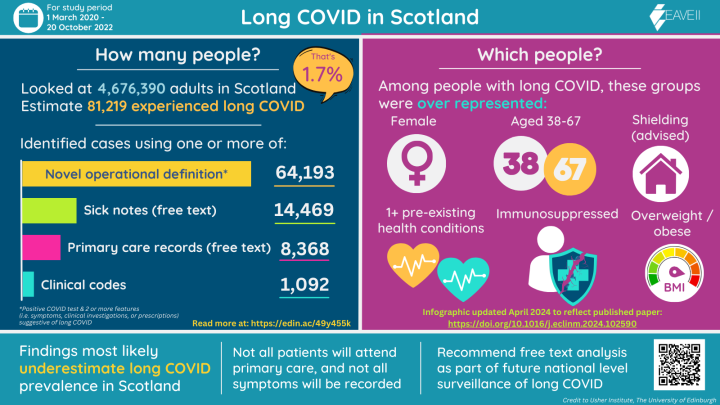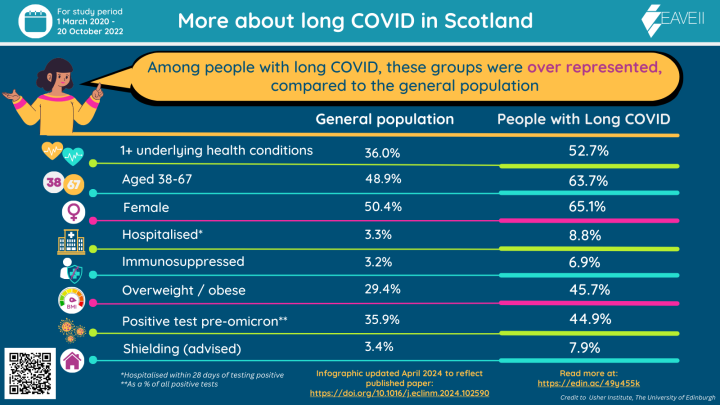Prevalence and risk factors for long Covid among adults in Scotland
April 2024: Research published in eClinicalMedicine looks at how many adults in Scotland have long Covid, based on electronic health records.
PLEASE NOTE: This research was originally published as a ‘pre-print’ article and has now undergone full peer review. There are some small changes to the numbers presented as a result of that process.
Read the original pre-print article

Prevalence and risk factors for long COVID among adults in Scotland using electronic health records: a national, retrospective, observational cohort study
Jeffrey, K; Woolford, L; Maini, R; Daines, L; et. al.
eClinicalMedicine, Volume 71
Published online on: 12 April 2024
Available online at: https://doi.org/10.1016/j.eclinm.2024.102590
These infographics were created by EAVE II Communications & Engagement Officer, Gabriella Linning (Usher Institute, The University of Edinburgh)
Summary in plain English
Long Covid was first recorded by patients who had ongoing symptoms after COVID-19 in May 2020. This new chronic condition develops after a person has been infected with coronavirus (SARS-CoV-2).
People with long COVID have reported a wide range of often debilitating symptoms, including:
- Extreme tiredness (fatigue)
- Difficulty thinking or remembering (cognitive dysfunction)
- Breathlessness
- Loss of taste or smell
These symptoms can last for months or years following the infection.
Why did we carry out this study?
Because long COVID is a new disease, we are still understanding how many people it affects. We have some idea from self-reported studies, but not from the entire population.
As well as the symptoms listed above, long COVID has been linked with a higher levels of other diseases. This includes type 2 diabetes, heart attack, stroke, nervous system disorders and blood clots.
Understanding how many people have long COVID is really important for addressing the scale of the problem in an evidence-based way. This includes setting up policies and healthcare which benefit people with long COVID, and those who support them.
What data did we use?
To estimate the number of people with long COVID in Scotland, we used data from routinely collected medical records. We created an ‘operational definition’ of long COVID, so that people could be identified based on their health records.
We analysed information for 4.7 million people from 1 March 2020 to 20 October 2022. The main types of data we used were:
- GP and hospital records, including formal clinical codes
- Prescriptions
- Lab tests.
Our data also included patient characteristics like age, sex, location, body mass index (BMI) and medical history to study who is at highest risk of developing long COVID.
We studied symptoms, tests and other records in the 4-12 and 12-26 weeks after a positive test.
What did we find?

Based on these data, we found that about 1.7% of the Scottish population had long COVID.
This is equivalent to 81,219 people. This number is still likely to be an underestimate. Not everyone who has long COVID may have visited their doctor or been formally diagnosed. Newly recorded cases of long COVID peaked in April 2022, when widespread COVID-19 testing was withdrawn in Scotland.
Very few long COVID cases were identified from clinical codes. Over three quarters (79%) of the people identified came from our newly developed operational definition.
We found that people with long COVID were more likely to:
- Be female
- Be 38-67 years old
- Have a Body Mass Index (BMI) of 25kg/m2 or more (i.e. overweight or obese)
- Have at least oneother underlying health condition
- Be immunosuppressed or previously asked to shield during the pandemic
- Have been admitted to hospital within 28 days of testing positive.
There were fewer cases of long COVID recorded when the Omicron variant of SARS-CoV-2 was most common, compared to the other variants seen in the UK.
Why is this research important?
This study is the first of its kind to provide an estimate of long COVID across a national population using free text in GP notes. The percentage of people (1.7%) is likely to be an underestimate, with self-reported surveys suggesting a range of 2-5%.
However, the study gives important information about:
- how many people in Scotland may have long COVID
- the characteristics of people who have long COVID
- who is at highest risk of developing long COVID
The research also highlights that clinical codes – as recorded in GP records – are of limited use in studying this condition. In the future, it might be valuable to make code entry easier for GPs, or to do more analysis on the free text recorded in consultation notes.
This work provides a basis for a prediction model for long COVID based on routinely collected data, which is the next step in our project.
Note
This plain English summary was written by EAVE II and Long COVID project's Patient and Public Involvement (PPI) Lead Dr Lana Woolford in consultation with members of the Long COVID PPI panel and data analysts.


